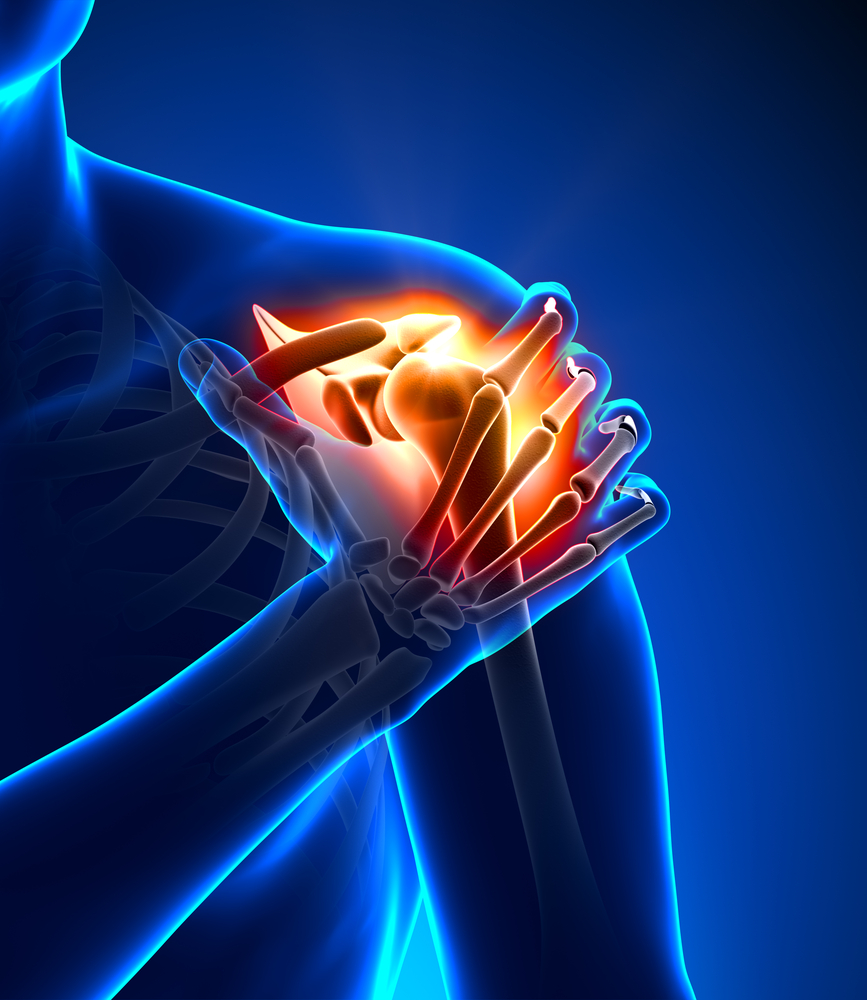If you have shoulder pain, you are not alone. Shoulder injuries are one of the most common soft tissue injuries people suffer from. The complex and unique anatomy of the shoulder makes it the joint with the greatest range of motion but with the least amount of stability.
In order to achieve this range of motion while maintaining a stable shoulder, there is a complex interplay between the joints, muscles and ligaments. Injury to any one of these structures can result in pain, weakness, or instability.
Types of Shoulder Pain
Here are a few of the most common shoulder issues and what you can do about it.
Rotator Cuff Injuries
The rotator cuff is one of the most important components of the shoulder. It’s made up of a group of muscles and tendons that hold the bones of the shoulder joint together. The rotator cuff muscles provide individuals with the ability to lift their arm and reach overhead. Rotator cuff tendonitis is a common rotator cuff injury. Tendonitis simply means inflammation and swelling of tendons–the tissue that connects muscle to bone.
There are several reasons for inflammation to occur, repetitive movements, sports injuries, aging, and poor posture. Many people suffer from shoulder tendonitis because of movements required by their jobs. Symptoms include swelling and pain, particularly in the front of the shoulder. Fortunately, physical therapy is a very effective treatment for rotator cuff tendonitis.
Another type of rotator cuff injury is a cuff tear. This is often caused by trauma or use over time. Symptoms of rotator cuff tear are weakness and pain in the shoulder. In most cases conservative approaches can help heal a rotator cuff tear. However, severe cases have required surgery.
Bursitis
All over your body, you have thin, sac-like structures called bursae, which cushions the area around many types of joints. According to the Mayo Clinic, bursitis occurs when bursae become inflamed, often brought on because of repetitive movements, or because of pressure put on the bursae for long periods of time. Shoulder bursitis symptoms include achiness in the joints, pain with movement, and swelling.
Arthritis
According to John Hopkins, shoulder arthritis is damage to the cartilage inside the shoulder joint. The shoulder has two joints. Shoulder arthritis commonly refers to the bigger ball-and-socket joint.
When the cartilage in the shoulder begins to break down on the surface and eventually in the deeper layers, it’s called shoulder arthritis. When a person experiences shoulder pain without a known injury, it may be caused by osteoarthritis or rheumatoid arthritis.
Frozen Shoulder
Also known as adhesive capsulitis, this is a common condition that leads to joint stiffness and pain. This condition can also lead to a decrease in both active and passive range of motion. While many shoulder conditions can be associated with frozen shoulder, the cause is often unknown. Risk factors include diabetes, thyroid problems, shoulder surgery, heart disease, or Parkinson’s disease.
Labral Tear
The labrum tissue helps cushion your shoulder socket, as it is the cup-shaped rim of cartilage that lines and reinforces the ball and socket joint of the shoulder. Tears to the labral tissue can cause pain and instability in the shoulder.
What To Do If You Have Shoulder Pain
Early diagnosis is the best way to relieve shoulder pain. Conservative approaches to treating shoulder pain are often the most effective. In some severe cases, surgery or injections may become necessary, but these measures should only be taken as a last resort.
At Couve Health our team of professionals can distinguish between the different types of shoulder pain and create a treatment plan for you. If you are experiencing any of these symptoms reach out:
-
Shoulder pain with fever, swelling, or redness
-
Problems moving the shoulder
-
Shoulder pain that lasts beyond a few days
-
Swelling or significant bruising around your joint or arm
- Red or blue color of the skin of the shoulder area

Treatment For Shoulder Pain
Rest – Rest is often the first plan of attack by giving the joint time to rest and allowing the inflammation or irritation to subside. Note on rest- too much rest can lead to joint stiffness.
Physical Therapy – Treatment from physiotherapists have shown to be very effective in treating shoulder conditions that cause pain such as rotator cuff injuries, shoulder arthritis shoulder impingements. Studies have shown it can even help delay or eliminate the need for surgery.
Pain Control – The most common types of medications to ease shoulder pain are NSAID’s and steroids. Some NSAIDs are available over-the -counter like ibuprofen, others are prescribed. Steroids would be provided by your healthcare provider. A shot of cortisone in the shoulder can help with pain and inflammation, making engagement with physical therapy easier.
Surgery – If the injury is severe enough surgery may be required. This is normally the last resort after therapy has been attempted.
At Couve Health we have a team of specialists to diagnose and determine your best treatment plan to full recovery. If you are experiencing shoulder pain, ignoring the pain won’t make it disappear. In fact, just the opposite. You could be extending the time of treatment and options for nonsurgical opportunities.
Book your appointment with Couve Health online by clicking here.
Sudden left shoulder pain can sometimes be a sign of a heart attack. Call 911 or your local emergency number if you have sudden pressure or crushing pain in your shoulder, especially if the pain runs from your chest to the left jaw, arm or neck, or occurs with shortness of breath, dizziness, or sweating.
Go to the hospital emergency room if you have just had a severe injury and your shoulder is very painful, swollen, bruised, or bleeding.


